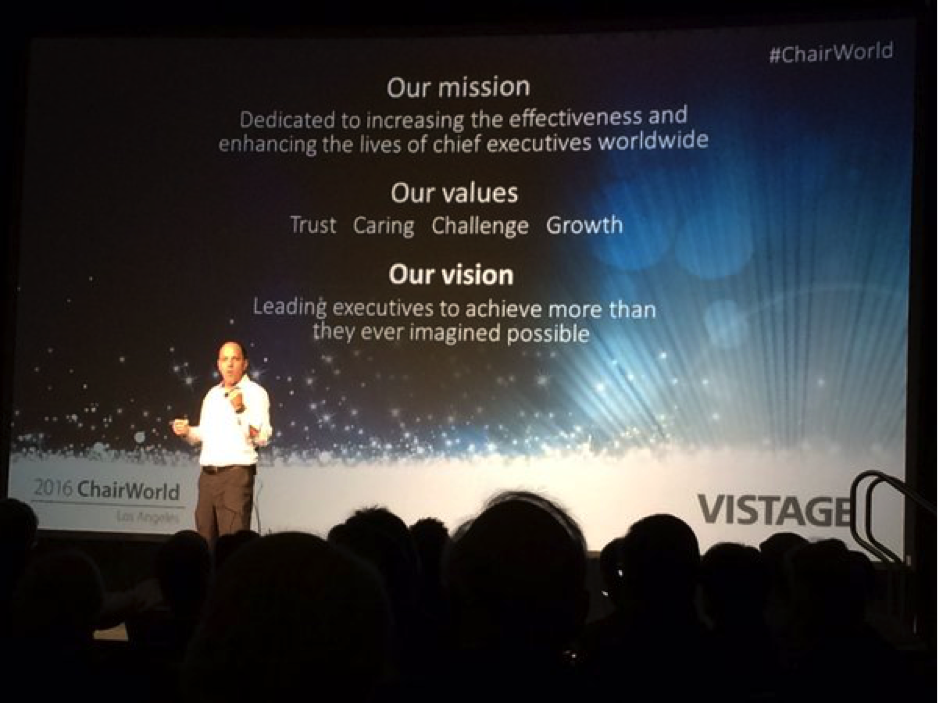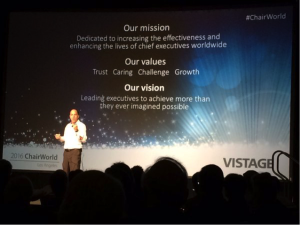Leadership Catalyst Blog

ChairWorld 2016 – Vistage Chairs Gathered in LA to “Sharpen the Saw” Together
Coaching, Human Capital, Leadership Development / 25.02.2016
What am I doing to continuously up my game? This question was top of mind as Vistage CEO Peer Advisory Board Facilitators from around the world gathered in Los Angeles earlier this month for ChairWorld 2016.
As a Vistage Chair and long time CEO coach, I frequently advise and assist my Vistage members and executive coaching clients as they work through stressful business challenges and weigh major decisions with company wide implications. I have the privilege of influencing the few that influence the many. For people like myself who are in the business of giving advice and facilitating issue resolution for a living, it can be easy to forget that even the best coaches and advisors in the field need to actively seek opportunities to up our game and build our knowledge banks so that we can bring more value to our clients and for our own good.
I appreciate that Vistage recognizes the importance of continuously “sharpening the saw” and provides opportunities such as ChairWorld for their professional chairs to do so. This is a key differentiator for Vistage as compared to many other chief executive peer group models.
Over 525 Vistage Chairs from all around the world came together for ChairWorld with the focus on how to improve as leaders and facilitators, learning from each other and fostering a stronger community. There were excellent keynote speakers, numerous breakout sessions to choose from, small-group workshops, formal and informal networking opportunities, and fun social events planned in the evenings.
The highlights of the conference for me included:
- Keynote address on leadership through adversity by polar explorer and top-rated Vistage speaker “Antarctic Mike” Pierce. Mike is the speaker that I have brought in to anchor my 4 Vistage Group meetings this week, and after listening to his talk at ChairWorld I know that my Vistage members are in for a treat.
- Breakout session on putting together a deal team when selling a business, led by legal and financial experts representing the buy and sell sides of transactions. A key question discussed was “how much lead time do you need for an exit” – a topic that I know to be relevant for some of my Vistage members.
- Dinner with the Vistage Colorado chairs – the Denver business climate is similar to Minneapolis in many ways. It was great to get to know the Colorado Vistage team better and to learn more about some of the innovative things that they are doing while also sharing the unique ways that the Minnesota team has been collaborating.
- Leading a “Wisdom Walk” session which paired chairs up to practice 1:1 coaching techniques so that the chairs could learn from each other
- Spending time with Lance Desceurez, the recipient of this year’s Vistage Pope Award which goes to the one chair out of 800 that best exemplifies our values and epitomizes the impact we as chairs strive for Lance is a good friend and mentor, and I know he will continue to help me raise my game as a chair this year.
One of my goals coming into ChairWorld was to look for opportunities around how I can improve my daily and monthly meetings with my members. Specifically, how I can inject more energy into my meetings and go deeper on issue processing to help my Vistage members and coaching clients understand the self-limiting beliefs that are holding them and their businesses back. I was also hoping to expand my Vistage community, increasing the number of chairs who I could pick up the phone and call as a friend, to talk through whatever the latest business issue or ideas we might have.
My experience at ChairWorld 2016 did not disappoint, and I am already applying my new learnings and building on new friendships.
So my question to all of my members and readers is: What are you doing to sharpen your saws? What is your version of Chairworld? Do you have a mentor or coach who is challenging you and helping you to become the best version of yourself. World class athletes have coaches to challenge them and keep them performing at the highest level – why shouldn’t you as a highly successful executive?
Read More >>
Women are now fairly well represented in the corporate middle management ranks, but there is still a glaring gap when it comes to women in top business leadership roles. One of the most frequent reasons cited is that women hit the “pause button” on their career advancement while they focus more of their energy on raising their families. While that is true for many, I’d like to explore a few of the theories regarding why there are not more women at the top and what it would take to change the paradigm.
In a TED talk entitled “The Career Advice you Probably Didn’t Get,” leadership expert Susan Colantuono contrasts the development plans of male vs female middle managers who are being prepared to take the next step in their career. A key difference that she points out is that men are being coached and trained on how to run the business (Strategic, Financial and Business Acumen) while women are being coached and trained on leadership and interpersonal skills. Leadership and interpersonal skills are important, particularly at the middle management level, but they are not enough for success at the top of the organization.
Colantuono defines strategic, financial and business acumen as “the skill set that has to do with understanding where the organization is going, what its strategy is, what financial targets it has in place, and understanding your role in moving the organization forward.” It is assumed that anyone in the running for a top management role embodies this skill set, but Colantuano points to this critical arena as the missing 33 percent of the career success equation for women. Her argument is not that women aren’t capable of excelling at strategic, financial and business acumen, but rather that the career advice and coaching that women are being given does not emphasize the importance of boldly and consistently demonstrating mastery of this essential skill set. Colantuono encourages women to seek out opportunities to showcase their strategic, financial and business acumen in their roles and to highlight these accomplishments when being considered for advancement opportunities.
Well known TV news personalities Claire Shipman and Katty Kay wrote an article in The Atlantic called The Confidence Gap addressing the disparity in career success between genders. They argue that confidence matters as much as competence in career advancement, and they point to evidence that suggests women are generally less self-assured than men. The authors highlight examples of extremely talented and credentialed famous women who despite their success, exhibit self-doubt when reminiscing about key moments in their careers. Shipman and Kay believe that the way for women to become more confident is to stop thinking so much and just act, a thought and behavior pattern which will become more ingrained over time with neuro plasticity.
I have a slightly different interpretation of what Shipman and Kay label “The Confidence Gap”. The Atlantic article talks about how women often lack the confidence to put themselves in risky or stretch business leadership roles. The authors label it as self-confidence, but to me it seems more like women holding themselves to a higher standard than men. By that I mean that in some cases, women seem to be more literal when assessing themselves against posted job requirements. A man may look at a list of job requirements and confidently apply if he meets half of them — An equally competent woman may be more likely to feel that she has to have all of the boxes checked to apply and be successful, which may not be the case.
Closing the Gender Gap
Organizations, leaders, and women need to understand that the Critical Success Factors for advancing to top executive positions are different than those required for excelling in middle management positions. The old adage that “What got you here won’t get you there” is especially true for making it to the top of organizations. Here are three ways we can help close the gender gap.
- Make sure the development plans of high performing women with high potential focus on building strategic, financial, and business acumen.
- Encourage high potential women to post for internal positions that they view as a stretch for themselves, even when they feel they don’t meet all of the requirements.
- Place high potential women in Vistage Private Advisory Boards. Investing one day a month with talented men and women from other companies to work “on the business” rather than just working “in the business” will not only improve their strategic and business acumen, it will increase their confidence and help them become better leaders, make better decisions, and get better results.
As a Vistage Chair, I am deeply committed to helping close the gender gap at the top. That is why my Vistage practice has more women members than any other chair practice in town, and why I am actively recruiting and mentoring women to become Vistage Chairs. If you would like to join me as a member or a fellow chair, please call me at 612.877.1234 or email me at Brian.Davis@vistagechair.com
Read More >>
Leadership Lessons From a 4 Year Old
All Blog Posts, Coaching, Motivation / 05.03.2014
We all need a little inspiration sometimes, and my inspiration today came from the story of an amazing 4 year old in Minnesota who started an outreach that has raised almost $20,000.
To kick off my monthly Vistage Executive Peer Group meetings, I often start by having members mention a business and personal highlight for the month. This serves to reconnect everyone and helps members transition to a day of working “ON’ the business rather than working “IN” the business. Last week Jim Glomstad, General Manager of SporTech, mentioned that Valentines day was a pretty big deal for his family because of his daughter Carly.
When Carly was four, she read a book about a girl that loved Valentine’s day so much she spent days making Valentine cards and goody bags and delivered them to everyone in town via her little red wagon. Carly loved the idea of doing something that would make many people feel special, and she decided to imitate her storybook hero in real life.
Carly raised $450 in her first year which allowed her to distribute 125 goody bags to kids at a crisis nursery and seniors at assisted living residences – people who she thought might need to feel special. That was 6 years ago, and she has expanded her outreach every year. This year she raised nearly $5,000 and delivered 500 goodie bags and cards while also funding a kids connection scholarship and donating to the crisis nursery.
She has her own website, (carlyvalentine.com) and last year she was featured on Kare11. She has raised almost $20,000 over the last 6 years.
Here are some leadership lessons I think we can all learn from this 4 year old:
1. Communicate a compelling vision – Carly wasn’t content to deliver a few goodie bags on her own street. She wanted to cheer up kids who were sick and seniors who may not get any visitors.
2. Go all in. Carly was willing to invest her life savings ($48.76 from her piggy bank) to make her vision a reality.
3. Create a vision larger than yourself. Carly inspired her parents, her family, her kindergarten class, and her girl scout troop to join her in her mission.
4. Follow your passion. Carly truly loves making people feel special, which fuels her willingness to do whatever it takes to get the job done and grow her outreach every year.
5. Have great mentors and a strong support system. Carly couldn’t have done this without the support and coaching of her parents, Jim and Tina Glomstad.
Thank you to the Glomstad family for being great role models and an inspiration to us all!
Read More >>
5 Questions to Ask Before Joining an Executive Peer Group
All Blog Posts, Coaching, Vistage Peer Groups / 17.12.2013
CEO peer groups provide a safe place for business leaders to discuss their most challenging business problems. Not all peer groups are the same however. Here are five things to consider before joining a peer group.
1. Who chairs the meetings?
Some executive coaching groups are run by volunteers, other groups rotate meeting facilitation duties amongst themselves, and still other groups rely on paid, highly trained, business leaders to keep the meetings on track and assure all members are receiving value.
Most business leaders find that the biggest expense in belonging to a group is not the membership fees – it is the value of the time that they spend in the meetings. A professional chair can dramatically increase the value you receive from those peer meetings.
To evaluate a chair’s credentials, ask:
- What is their education and experience – not only in running a business, but in executive coaching and group facilitation?
- What national awards or recognition have they received for their chairing?
- How do they measure their own effectiveness and the effectiveness of their group?
- What do they do to continually improve their skills as a group chair?
- To what extent are they sought out as an expert by local and national media?
- What do their members say about them on their website or on LinkedIn?’
2. Is monthly individual mentoring and executive coaching included?
World-class athletes and other professionals have a coach, why shouldn’t you?
Find out if members meet monthly with their chair to dig deeper into challenges and opportunities and to make sure they are getting the very best their peer group has to offer.
3. Who else is in the group?
Make sure there are several people in the group who have been where you are going and have expertise and experience that you don’t.
- In addition to assuring there are no direct competitors in the group, attend a meeting to find out:
- Are there companies of various sizes and industries?
- Are some recognized as leaders in their industry?
- How do you feel about the chemistry of the group?
- Are members helping each other with critical issues?
- Do they challenge one another and ask the tough questions?
- Do they support one another?
- Do people seem to enjoy being there?
4. What access do you have to business expertise outside of your peer group members?
Although the interactions you have with your immediate peer group members are invaluable, CEO peer groups are more effective when additional resources enrich the experience.
Consider these questions:
- Does the group bring in great speakers?
- Is there a broader community in your city, state, country or globally that you can call on for help?
- Do they have a website to connect with other members and leading experts to get help between meetings?
5. Are there groups for their direct reports?
A key barrier to growth is having strong people beneath you so that you can elevate and delegate. Is there a way to help them grow their people in addition to themselves?
Brian L. Davis, PhD is the leading Vistage chair in Minnesota. With one of the highest-rated Vistage chair practices in the country, Mr. Davis has coached some of the top executives in the Twin Cities. Mr. Davis business leadership coaching skills have been noted by a variety of publications, including The Minneapolis Star Tribune, The Minneapolis/St. Paul Business Journal, and Entrepreneur Magazine.
Read More >>
The Top 5 Reasons Why Minnesota Entrepreneurs Join Vistage Peer Groups
All Blog Posts, Coaching, Vistage Peer Groups / 27.11.2013
As one of the leading business coaches in the Twin Cities, I routinely hold executive peer groups featuring the state’s top CEOs and entrepreneurs.
Everyone has a unique set of motivators for joining a Vistage CEO Peer Group, but there are five reasons that I continually encounter:
1. Better business results, quicker
Most entrepreneurs didn’t go to “CEO school.”
These entrepreneurs are typically great at sales, developing innovative products, putting together deals, or they may be taking the reins of a family owned business. Regardless of how they have come to lead their businesses, most entrepreneurs are self-taught and have learned by trial-and-error.
2. Learning from failure, without failing
Failure is the best learning tool – but it doesn’t have to be your own failure.
Many entrepreneurs join Vistage peer groups because they want help making better decisions and they want to learn from the experience of others’ mistakes rather than making the same mistakes themselves.
3. Leadership Growth
Minnesota entrepreneurs that join Vistage often seek to become better leaders.
Vistage CEO peer groups have peers who will push entrepreneurs out of their comfort zones to address the business and personal challenges that are holding them back.
4. Camaraderie
Entrepreneurs often seek relief from the isolation that comes from running an organization.
It really can be lonely at the top, and entrepreneurs need a confidential sounding board with whom they can be vulnerable and discuss their failures and fears, not just their successes.
Friends and family can lend a sympathetic ear, but they usually don’t have the experience to be helpful or the perspective to help the entrepreneur see what they are doing to create a problem. An entrepreneur’s own company executives may have their own agendas or lack the courage to tell them the kind truth, and a board of directors responsible for CEO evaluation and succession is often not the first place they want to go for help.
5. Growth Acceleration
Vistage group members want access to business experts and resources that will help their businesses thrive and enhance their lives.
For example, at least six times a year, best-in-class speakers come to our meetings to do workshops on critical topics including:
- Creating a culture of alignment and accountability
- Increasing employee engagement
- Building a world-class sales organization
For specific issues, entrepreneurs can get referrals to local professional service firms who other members have used to get great results at a reasonable price.
Brian L. Davis, PhD is the leading Vistage chair in Minnesota. With one of the highest-rated Vistage chair practices in the country, Mr. Davis has coached some of the top executives in the Twin Cities. Mr. Davis business leadership coaching skills have been noted by a variety of publications, including The Minneapolis Star Tribune, The Minneapolis/St. Paul Business Journal, and Entrepreneur Magazine.
Read More >>How to Increase Accountability
All Blog Posts, Coaching, Performance Management, Vistage Peer Groups / 22.11.20111 comments
In a recent Vistage meeting, a theme that emerged was how to better hold others accountable. People often agree in meetings to things with “their fingers crossed”, and don’t deliver on commitments. While this is the subject of many books and training programs, one quick fix is to assure that you have a “Level 5” agreement.
James Newton, CEO of Newton Learning corporation and longtime Vistage Speaker, outlines 5 levels of agreement. Below is a brief description of each agreement level, illustrated by a simple example of setting up a golf game. As you read the scenarios, consider the level of agreement you have achieved in those instances where people have not delivered on commitments.
Level 1 Agreement: No agreement at all.
Brian: “Hey Mike, what do you say we play golf after our next meeting.”
Mike: “There’s an idea.”
Level 2 Agreement: Likes the idea, but no agreement.
Brian: “Hey Mike, let’s play golf after our next meeting.”
Mike: “Good idea!”
Level 3 Agreement: Reluctant agreement–but no commitment to do anything.
Brian: “Mike, Let’s play golf after our next meeting.”
Mike: “Man, I am really swamped, I better not.”
Brian: “Come on Mike, this will probably be our last chance before snowfall.”
Mike: “OK, I’m in.”
Level 4 Agreement: Enthusiastic agreement–but no commitment to do anything.
Brian: “Mike, let’s play golf after our next meeting”
Mike: “Great idea! Count me in.”
Level 5 Agreement: Specific commitment of who is going to do what by when, stated by the accountable person.
Brian: “Mike, let’s play golf after our next meeting”
Mike: “Great idea!” I’m in.”
Brian: “Where do you want to play.”
Mike: “Let’s play at my club. I’ll make a tee time for after our meeting.”
Brian: “How about if we have our meeting at your club so we can tee off right after that.”
Mike: “Great, I’ll meet you at my club for our monthly one-to-one on Friday at 2:00 pm and make a tee time for 3:30 pm.”
♦♦♦♦♦♦♦♦♦♦♦♦♦♦♦♦♦♦♦♦♦♦♦♦♦♦♦♦♦♦♦♦♦♦♦♦ LEADERSHIP CATALYST TIP ♦♦♦♦♦♦♦♦♦♦♦♦♦♦♦♦♦♦♦♦♦♦♦♦♦♦♦♦♦♦♦♦♦♦♦
Accountability increases with the level of agreement. If you are having trouble holding people accountable, push for a Level 5 Agreement, with a specific commitment to what is going to get done, by whom, and by when that is stated by the accountable person. It may take a little longer, but it will increase accountability and execution–and will save you a lot of time in the long run.
♦♦♦♦♦♦♦♦♦♦♦♦♦♦♦♦♦♦♦♦♦♦♦♦♦♦♦♦♦♦♦♦♦♦♦♦♦♦♦♦♦♦♦♦♦♦♦♦♦♦♦♦♦♦♦♦♦♦♦♦♦♦♦♦♦♦♦♦♦♦♦♦♦♦♦♦♦♦♦♦♦♦♦♦♦♦♦♦♦♦♦♦♦♦♦♦♦♦♦♦
Driving Business Results through Employee Engagement
All Blog Posts, Business, Coaching, Motivation, Strategy, Team Building / 08.05.2010
A couple of months ago, I highlighted Daniel Pink’s work on intrinsic motivation in my February 24th blog post entitled “When Traditional Motivation Doesn’t Work”. I concluded that post with the following tips.
♦♦♦♦♦♦♦♦♦♦♦♦♦♦♦♦♦♦♦♦♦♦♦♦♦♦♦♦♦♦♦♦♦♦♦ LEADERSHIP CATALYST TIPS ♦♦♦♦♦♦♦♦♦♦♦♦♦♦♦♦♦♦♦♦♦♦♦♦♦♦♦♦♦♦♦♦♦♦♦
In several turnaround situations, I have found the key to motivating and engaging employees is to:
- Make them feel valued as people and that they belong
- Help them see how what they do makes a difference, and
- Find a way for them to monitor their own contributions on an ongoing basis.
♦♦♦♦♦♦♦♦♦♦♦♦♦♦♦♦♦♦♦♦♦♦♦♦♦♦♦♦♦♦♦♦♦♦♦♦♦♦♦♦♦♦♦♦♦♦♦♦♦♦♦♦♦♦♦♦♦♦♦♦♦♦♦♦♦♦♦♦♦♦♦♦♦♦♦♦♦♦♦♦♦♦♦♦♦♦♦♦♦♦♦♦♦♦♦♦♦♦

- Employee Engagement
I recently stumbled upon a research study which validates these principles, shows how employee engagement and customer loyalty drive financial results, and illustrates how to execute these principles in a grocery store environment. The study was sponsored by the Coca-Cola Retailing Research Council and is entitled “Getting to Great: Mapping Management Practices that Drive Great Store Performance”.
The article is about 30 pages long, but well worth the time, even if you aren’t in the grocery business. Historically, the key to success in store operations has been seen as execution, and “command and control” has been a dominant leadership approach. Seeing how the above principles of employee engagement work in this situation should increase our confidence that they will work in situations involving more ambiguous and complex challenges. Below is a quick recap of their findings.
First, how do we know a great performer when we see one?
- “Great performers are those that overachieve relative to their market potential, not just those with the highest financial results.” Store results are a function not only of the leader’s performance, they are tremendously impacted by the store’s location, customer potential, competitive intensity, and store specific factors. The researchers devised a clever way of controlling for these external factors to show which store managers are executing most effectively against the strategic hand they have been dealt. (pp. 4-6)
- “Great Performers generate intense customer loyalty”.
- “Great performers produce strong employee loyalty and commitment.”
Second, what are the key management practices that great performers use to get these results?
- “Get clarity and commitment to goals. The great performers focused on the one or two most vital goals for improving their store’s performance and put their full focus behind them. By contrast, the more goals there were, the fewer were achieved with excellence.
- Get everyone to focus on the key drivers. Enlist each team member daily to take actions that have the greatest impact on achieving the main goals.
- Implement simple mechanisms to propel goal achievement. Post visible, compelling scorecards in accessible workplace locations.
- Establish a constant cadence of engagement and accountability around the key measures and goals.”
While this is a good recap, go to the report for the specifics of how to measure great performance results and the specific leadership behaviors that lead to it. It is sure to be a catalyst for ideas on how to do the same in your business!
Read More >>Algebraic Proof that Tubby Smith’s Gophers became the Best Team in the Country after working with a Leadership Catalyst!
All Blog Posts, Change, Coaching, Motivation, Team Building / 02.04.2010
On March 1st, I posted a blog about Tubby Smith bringing in a Leadership Catalyst (sports psychologist) after winning only 3 of 10 Big Ten games. On the eve of the final four, it’s time to assess whether the team really improved after that.
The gophers showed dramatic improvement, winning 7 of their last 10 conference games. They ended up beating every Big Ten team making the NCAA tournament, including impressive wins in the Big Ten Tournament against #11 MSU and #6 Purdue, which won the gophers their own invitation to the “Big Dance”. They were the only team in the nation to beat two of the Final Four teams (Butler and MSU) and beat teams that beat Duke (Wisconsin) and beat West Virginia (Purdue). According to the Algebraic Transitive Property of Inequalities (see proof below), that makes the Gophers the best team in the nation.
There you have it – mathematical (and tongue in cheek) proof that the Gophers are #1.
Congratulations Tubby, on your 17th consecutive 20 win season (21W – 14L)!
♦♦♦♦♦♦♦♦♦♦♦♦♦♦♦♦♦♦♦♦♦♦♦♦♦♦♦♦♦♦♦♦♦♦♦ LEADERSHIP CATALYST TIPS ♦♦♦♦♦♦♦♦♦♦♦♦♦♦♦♦♦♦♦♦♦♦♦♦♦♦♦♦♦♦♦♦♦♦♦
According to the Transitive Property of Inequalities,
If a < b and b < c, then a < c
Likewise:
If a > b and b > c, then a > c
If Minnesota > Wisconsin and Wisconsin > Duke, then Minnesota > Duke
If Minnesota > Purdue, and Purdue > West Virginia, then Minnesota > West Virginia
Minnesota > Butler
Minnesota > Michigan State
Therefore,
Minnesota > All Final Four Teams
♦♦♦♦♦♦♦♦♦♦♦♦♦♦♦♦♦♦♦♦♦♦♦♦♦♦♦♦♦♦♦♦♦♦♦♦♦♦♦♦♦♦♦♦♦♦♦♦♦♦♦♦♦♦♦♦♦♦♦♦♦♦♦♦♦♦♦♦♦♦♦♦♦♦♦♦♦♦♦♦♦♦♦♦♦♦♦♦♦♦♦♦♦♦♦♦♦♦
How to talk to people about their potential for advancement.
All Blog Posts, Assessment, Coaching, High Potential Programs, Leadership Development, Motivation, Performance Management, Succession Planning, Talent Management / 31.03.2010

- Discussing Leadership Potential
Several organizations go through great lengths to identify their high potential leaders (HIPOs), and then seem to operate on a “don’t ask/don’t tell” policy. They fear that informing the HIPOs will cause them to coast or develop a sense of entitlement. Furthermore, they worry that those that are not deemed as HIPOs may feel they have no future and decide to leave or slack off. On the other hand, if you don’t inform the HIPOs, your brightest stars may assume their advancement opportunities with you are limited, and take that next headhunter call. Other organizations wanting to upgrade their talent are more than willing to tell them how bright their future will be with them, even if you are not.
One of the things that gets in the way of these discussions are the assumptions some organizations are making as they communicate potential including:
- Potential is a single trait—it’s not. It varies by management level and is multi-dimensional.
- You have it or you don’t. Not true, it is a continuum.
- It doesn’t change. Again, not true. A key component of potential is the person’s aspirations and interests, which can change with life circumstances and experience.
- Performance and potential are treated as independent measures (e.g.” 9 box grids”). From a motivational and retention perspective, there is tremendous power in letting performance “trump” potential, especially at lower management levels.
Thinking about potential as a dynamic, continuous, multi dimensional construct dramatically improves the quality of these discussions, particularly when done within the context of performance discussions. If you assume that performance trumps potential, the key message to everyone is that before you can be promoted to the next level, you need to become a top performer (e.g. top 20%) in your current role. That means the discussion for 70-80% of your people is focused on the “what’ and “how” of this year’s performance, celebrating their successes and figuring out how to fill their gaps. The main message for people who are not yet top performers but are seeking advancement is that they need to master their current role before focusing on the next one. While you can discuss their aspirations, interests, and career possibilities, the focus of the discussion with this group is on helping them achieve the level of performance required to be considered a top performer in your organization.
The discussion with top performers who are also seen as having high potential is the kind most bosses love to have. In this discussion you are celebrating their strong performance and signaling to them that they are highly valued and are seen by senior management as having the potential to move up in the organization. You are also exploring their aspirations (not everybody wants to move up these days) and talking about some of the most likely next roles and what they need to do to prepare for them.
The discussion with top performers who are not seen as having the potential to move up is the one that is most dreaded. Keep in mind, a large percentage of these people love what they are doing and have no interest in moving up. For these folks, the focus of the discussion is on celebrating their contributions, letting them know how much they are valued, and communicating that they have a bright future with the organization.
For those in this group with their hearts set on advancement, however, the conversation is a bit more delicate. After hearing more about the roles to which they aspire, the discussion needs to focus on how the success factors for those roles are different, and where they are likely to have some gaps. (E.g. Just because you are a great sales person doesn’t mean you will be a great sales manager.) For openers, you can talk about aspects of potential that are important in successfully advancing to all management levels such as conceptual problem solving, self-confidence, emotional control, and willingness to accept responsibility. As you move to senior leadership roles, other facets of potential such as vision, adaptability, willingness to take risks, and stress tolerance come into play. For additional ideas, there is an excellent book by Marshall Goldsmith entitled “What Got You Here Won’t Get You There” in which he lays out the 20 most frequent career derailers.
Tubby Smith, U of MN BB Coach, Hires Catalyst
All Blog Posts, Change, Coaching, Motivation, Team Building / 01.03.2010
 Tubby Smith, the University of Minnesota men’s basketball coach has 16 consecutive 20 win seasons for a reason. He is a great coach, and he recognizes when it is time to find a catalyst to help unlock the potential of his team. This year’s 17-11 team is likely not performing up to its true potential because 7 of their 11 losses were decided by less than 5 points. They have had major leads over ranked teams such as Michigan State and Purdue, only to see them erased in the final seconds. In fact, they have only won 4 of 11 close games this season.
Tubby Smith, the University of Minnesota men’s basketball coach has 16 consecutive 20 win seasons for a reason. He is a great coach, and he recognizes when it is time to find a catalyst to help unlock the potential of his team. This year’s 17-11 team is likely not performing up to its true potential because 7 of their 11 losses were decided by less than 5 points. They have had major leads over ranked teams such as Michigan State and Purdue, only to see them erased in the final seconds. In fact, they have only won 4 of 11 close games this season.
In an effort to find a remedy to the mental breakdowns his team was having with the game on the line, coach Smith brought in a sports psychologist according to Myron Medcalf of the Minneapolis Star Tribune. Players report that he taught them to use “positive affirmations” and envision good outcomes in tough stretches. They further claim that the approach helped them survive a late game surge by the fighting Illini in a 62-60 victory on Saturday.
For many, “positive affirmation” conjures up images of SNL’s Stuart Smally (aka Senator Al Franken) looking into the mirror and saying “…and darn it, people like me”. However, there is a lot more science to them than that, and no doubt you have recently observed Olympians mentally rehearsing flawless performances on the slopes and on the ice before they compete. This same technique works in coaching executives before tough board meetings or critical or contentious negotiations.
♦♦♦♦♦♦♦♦♦♦♦♦♦♦♦♦♦♦♦♦♦♦♦♦♦♦♦♦♦♦♦♦♦♦♦ LEADERSHIP CATALYST TIPS ♦♦♦♦♦♦♦♦♦♦♦♦♦♦♦♦♦♦♦♦♦♦♦♦♦♦♦♦♦♦♦♦♦♦♦
To increase the odds of success for executives in these critical situations, help them:
- Imagine themselves in the situation
- Anticipate the tough questions and challenges they likely will encounter
- Visualize themselves calmly and effectively responding to those challenges
- Practice responding to those challenges with someone playing an adversarial role.
♦♦♦♦♦♦♦♦♦♦♦♦♦♦♦♦♦♦♦♦♦♦♦♦♦♦♦♦♦♦♦♦♦♦♦♦♦♦♦♦♦♦♦♦♦♦♦♦♦♦♦♦♦♦♦♦♦♦♦♦♦♦♦♦♦♦♦♦♦♦♦♦♦♦♦♦♦♦♦♦♦♦♦♦♦♦♦♦♦♦♦♦♦♦♦♦♦♦
The bottom line is that effective coaches and business leaders recognize when their teams are not performing up to potential, and do not hesitate to find a catalyst to help them get back on track.
Read More >>The HBR IdeaCast on “What Motivates Us” will be very relevant to people struggling with how to motivate their employees, their kids, or themselves. In this 16 minute audio session, Daniel Pink (Author of the new book Drive) explains why much of what we know about motivation doesn’t work. Some of his key points include:
 1) Strong emphasis on carrot and stick motivators are good for simple tasks, but not good for complex cognitive tasks or tasks that require creativity
1) Strong emphasis on carrot and stick motivators are good for simple tasks, but not good for complex cognitive tasks or tasks that require creativity
2) More powerful motivators for complex or creative tasks include assuring people feel that they have a sense of purpose, are making a contribution, are seeing progress, and are growing and getting better at something.
3) De-motivators include doing the same thing over and over without a sense of purpose or progress.
♦♦♦♦♦♦♦♦♦♦♦♦♦♦♦♦♦♦♦♦♦♦♦♦♦♦♦♦♦♦♦♦♦♦♦ LEADERSHIP CATALYST TIPS ♦♦♦♦♦♦♦♦♦♦♦♦♦♦♦♦♦♦♦♦♦♦♦♦♦♦♦♦♦♦♦♦♦♦♦
In several turnaround situations, I have found the key to motivating and engaging employees is to:
- Make them feel valued as people and that they belong
- Help them see how what they do makes a difference, and
- Find a way for them to monitor their own contributions on an ongoing basis.
♦♦♦♦♦♦♦♦♦♦♦♦♦♦♦♦♦♦♦♦♦♦♦♦♦♦♦♦♦♦♦♦♦♦♦♦♦♦♦♦♦♦♦♦♦♦♦♦♦♦♦♦♦♦♦♦♦♦♦♦♦♦♦♦♦♦♦♦♦♦♦♦♦♦♦♦♦♦♦♦♦♦♦♦♦♦♦♦♦♦♦♦♦♦♦♦♦♦
This is especially true now as companies try to re-engage their people after multiple rounds of layoffs, furloughs, and salary cuts. If they don’t, they risk losing their best people when the economy and job market improve.
Read More >>




